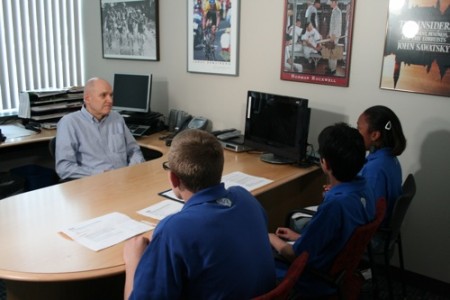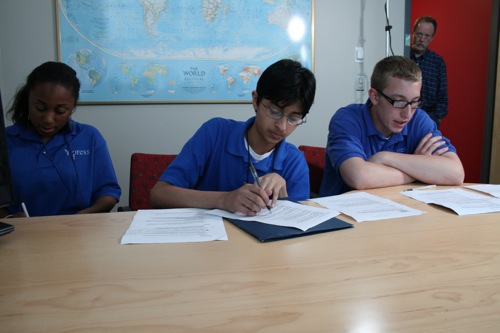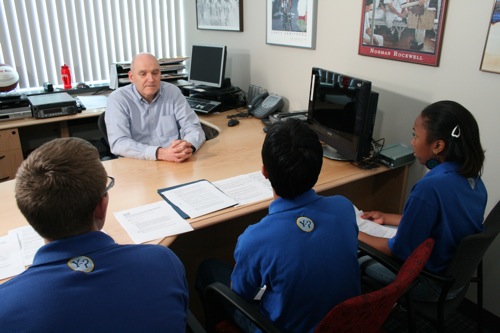Power of the Question
Lesson 4: Application! Application! Application!
 Because this lesson is geared toward multiple grade levels and subjects, it is general. Depending on how a teacher plans to use this lesson and the needs of students, below are several options for gearing up, gearing down, or extending this lesson.
Because this lesson is geared toward multiple grade levels and subjects, it is general. Depending on how a teacher plans to use this lesson and the needs of students, below are several options for gearing up, gearing down, or extending this lesson.
OPTION A: RESEARCHING
- Write an upcoming unit title on the board. For example, “Beat Generation,” “Lifestyle in the 1920s” or “Civil Rights Movement of the 1960s.” Based on this title, have students brainstorm research or inquiry questions to investigate.
- Designate a classroom board where the student questions can be placed. After the list of questions is on the board, ask the students to choose one question that intrigues them.
- The students should then take the question and research it. Make sure students compile their sources. If the question does not fulfill the open-ended, lean, and neutral requirements, the question will need to be rewritten by the student.
OPTION B: CONTENT-BASED DISCUSSION
- Teacher selects articles related to unit or topic of study. On individual sheets of chart paper, write article title. Post multiple titles around the room. Ask students to select one title that interests them and to generate three questions based only on the title. Based on the title, what would they want to know? What would they be searching for in the article? Have students record their questions on the chart paper beneath the title, allowing students to see the diversity of questions that arise from a simple title.
- Next have students read the article with the title they selected. As they find the answers to their own questions, highlight this information in the text.
- Discuss the articles as a class. Where students able to answer their questions? How could the questions be improved? What other questions were generated after reading the article?
OPTION C: INTERVIEWING
- Discuss researching and preparing questions for an interview and how that can help reporters write better questions.
- Have students generate a question rubric based on what they have learned about good qualities of questions. What are the qualities of a good question?
- Have students use that rubric to evaluate an interview of their choice. (They can search for video clips or podcasts or even look for print interviews.) This could lead to a larger discussion about interviewing. Students could eventually prepare their own interview questions for a story.
OPTION D: EVERYDAY QUESTIONS
- Have students brainstorm a list of situations where they use questions every day. Alternatively, have students keep a list of questions posed to them in a single day.
- Give students a note card with a role/career (examples: mom, dad, teacher, doctor, fast food worker). Have students write questions on the other side of this note card that this person might ask in his or her daily life. Encourage students to improve these standard questions to make them more open, neutral, and lean. A typical question might be a parent asking, “Have you finished your homework?”
ACROSS THE CURRICULUM
- Government/civics: Select a controversial current political issue and have students create a list of questions surrounding this issue, reminding them to follow Sawatsky’s tips for good questions. This could lead well into research and/or a debate (Ex. nuclear disarmament)
- U.S. History & World History: Brainstorm questions about a certain time period. Then have the students watch a movie clip/interview/podcast about that subject. After the clip have the students reflect on which of their questions were answered and what questions they still have or gained from the clip. (Ex. The Holocaust)
- English: Brainstorm questions about a possible research topic. Use those questions to investigate more about that topic. (Ex. While reading To Kill A Mockingbird, students could choose themes from the book, like prejudice, loyalty, etc, and create questions about those themes. Then they could use those questions to explore societal themes for a presentation or paper about their topic.)
- Economics: Use the title activity from Option B. Select articles pertaining to the environment and the possible economic implications (Ex. pollution control – How clean is clean enough?)
- Journalism: Create questions for interviews paying special attention to What, How and Why questions. Students would then conduct interviews to either produce a story, podcast or broadcast. Those products could be shared in class to see how students applied their knowledge.
ASSESSMENT
There are several assessments built into this lesson, including:
- Informal checking for understanding using questioning
- Student-generated questions
- Graphic organizers
- Illustration of a sin
- Q2 handout from part two
- Method in Action skits
ADDITIONAL RESOURCES
Articles about John Sawatsky:
- “The question man”
- “What to do”
- “What to Avoid”
- “Ask and Ask Again (and Again)”
- “The Art of the Interview”
- “Tools of the Trade: The Question”
STANDARDS
This lesson meets content and skill standards across the middle and high school curriculum. In particular, this lesson addresses standards related to communication, research skills, critical thinking, and inquiry. Such standards can be found in a range of different disciplines, including Language Arts, Social Studies, Technology, Journalism, and Science. We encourage you to review state standards to determine what standards are applicable to your classroom. National Standards may also prove helpful and can be located at:
- National Council for Teachers of English
- National Council for the Social Studies
- National Educational Technology Standards
- Journalism Education Association
If no state standards for journalism exist, see Language Arts. For Indiana, IN-JRN 4 (Journalistic Writing Processes):
(For more specific explanation, please click here.)
Copyright 2009 Y-Press



